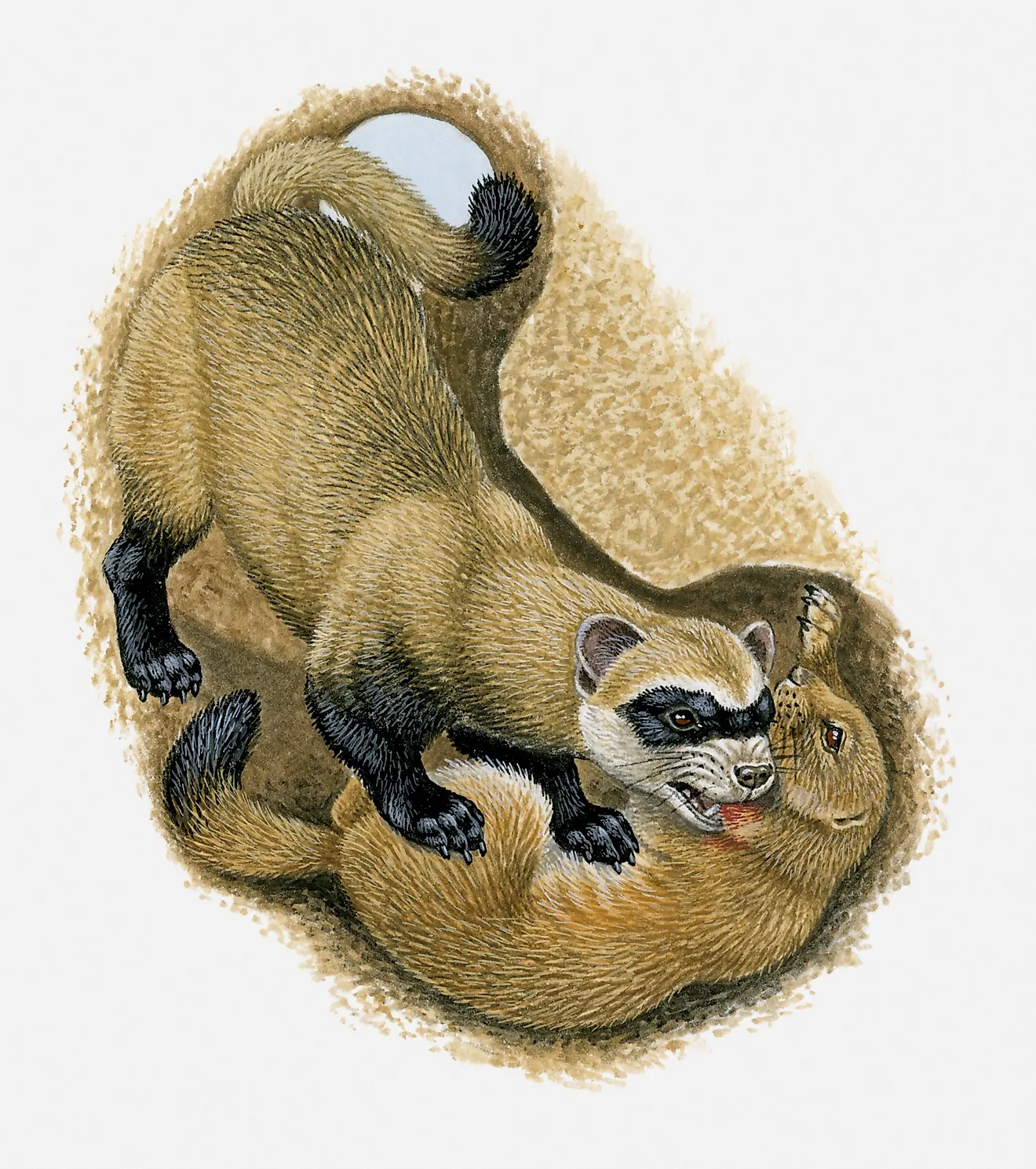Black-Footed Ferret Facts: Animals of North America

5. Physical Description
The black-footed ferret belongs to the weasel family. Its length from head to rear is between 38 and 50 centimeters, and it has an 11- to 13-centimeter tail, according to National Geographic. The black-footed ferret weighs from 1.5 to 2.5 pounds, according to Defenders of Wildlife (DOW). At the top of the head around its eyes, the fur is dark. Down its spine its fur is yellowish-brown, and dotted with specks of darker fur. It has a tiny snout with whiskers, and small ears. The fur on its side and the middle part of the tail is pale yellow, though the tails tips are dark. The black-footed ferret is named for its short black feet, which have long, clawed paws suitable for hunting.
4. Diet
The black-footed ferret is carnivorous and primarily preys on the prairie dog, which constitutes over 90 percent of its diet, according to World Wildlife Fund (WWF). Annually, an adult can consume over 100 prairie dogs and to find them the black footed ferret glides right into their tunnels. While within, it kills the prairie dog with a swift bite to the neck. Small rodents, such as Squirrels, mice, and gophers, as well as rabbits and birds, also form lesser parts of the Black Footed Ferret’s diet. As it has a high metabolic rate, it requires large food quantities, and on average each consumes one prairie dog every 3 to 4 days, according to Conserve Nature (CN).
3. Habitat and Range
the North American Great Plains, extending from the U.S. into Northern Mexico and Southern Canada, were once the ranges where the black footed ferret was found. Habitat in these ranges is intermountain, short, mixed, prairie and semi-arid grasslands. In these habitats, the black-footed ferret lives in abandoned prairie dog burrows. It’s also "Endangered" species, according to a 2015 International Union for Conservation of Nature (IUCN) Red List report. Estimates by WWF and IUCN report around 500 black-footed ferrets remain in the wild today. The decline in its population has been attributed to conversion of its natural habitats for commercial agriculture, as well as habitat fragmentation, mustelid diseases, and an overdependence on prairie dog populations for food. In fact, prairie dogs are commonly targeted by farmers as pests, which can result in inadvertent poisoning of the ferrets that used to naturally keep their numbers in check.
2. Behavior
The black-footed ferret is a solitary and nocturnal creature. According to a Defenders of Wildlife report, it spends about 90 percent of its time within burrows, only coming out them at night for short periods to hunt. The black-footed ferret is also nomadic, and has no set burrow for permanent living, according to Conserve Nature. Still, it can have a home range that covers about 100 acres. When in danger, especially from natural predators such as golden eagles, owls, or coyotes, the black ferret hisses or chatters, according to National Geographic. To aid in retracing its tracks after nighttime excursions and to maintain dominance, these ferrets urinate or defecate along the way, according to Animal Diversity.
1. Reproduction
Sexual maturity for the black-footed ferret is achieved at around the age of one year. Mating season for the ferrets, according to the U.S. Fish and Wildlife Service, runs through March and April. After mating, its gestation period takes 41 to 43 days and, on average, 3 to 4 kits will be born. These kits are born blind and helpless, and the female ferret is the one that must care for them. After 35 days, the kits open their eyes and, at 70 days, come up out of the ground to the surface. According to Conserve Nature, the peak reproductive period of a black-footed ferret is between 3 and 4 years. Their lifespan in the wild is 3 to 4 years but, in captivity, they may live to reach 9 to 13 years of age.











